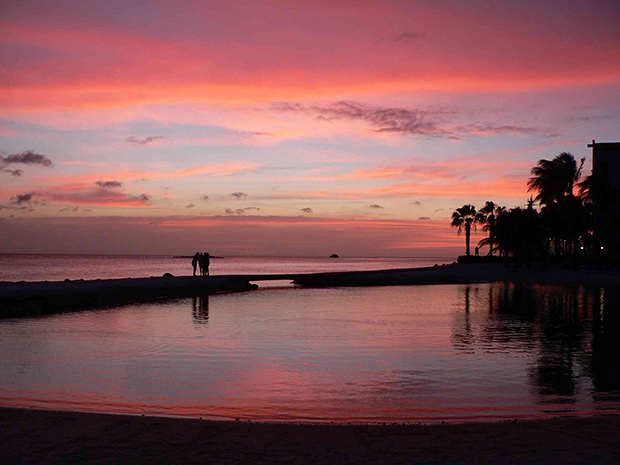A Place in the Sun

By Ed Curtis
Aruba is one of the more interesting islands in the Caribbean chain. Sitting barely 40 miles off the coast of Venezuela, the prevailing winds gently blowing from the mainland almost always negate the need for air-conditioning.
As a result of the never-ending Venezuelan breeze, Aruba is dotted throughout the island with what appear to be giant Bonsai trees. In fact, the divi-divi trees with all of their leaves and branches facing northward, lend a mystic look to the island. The constant wind forces the branches and leaves to one side of the tree while the southern-facing side is nearly bare.
There are two sides to Aruba, the beautiful west coast with its seven-mile strip of pure white sand beach and resorts lining the edge of the water and the rugged eastern coast with its “Middle Earth” looking jagged rocks carved out over eons by the wind.
Aruba is moving headlong into the future with the intention of becoming totally green in the not-so-distant future. Today there are almost a dozen windmills on the windy eastern shore that provide much of the island’s energy needs. Plans are in the works to greatly increase that number and make Aruba one of the few places receiving all of its electricity from renewable sources.
There is also an East Coast cave that has become a major attraction. Walk inside and a near perfect circle of light illuminates a small section of the cave floor. The light streams down from an opening in the cave’s roof. One word of caution... if you don’t like bats, let someone else show you his pictures of the cave’s interior.
Resorts line the Eastern coast with access to the beach and the warm Caribbean waters only yards from your hotel. Watersports enthusiasts can either swim, scuba, snorkel or jack up the adrenaline while kite surfing and parasailing.
For those who enjoy more land-based sports, a Robert Trent Jones designed golf course will offer enough of a challenge to keep the interest of both duffers and would-be PGAers.
Although the island has numerous towns and villages dotted across its relatively level interior, Oranjestad, its capital, is well worth the time for a self-guideded walking tour. There are many shops and some absolutely wonderful restaurants.
While most of the local folk speak Dutch and Papiamento, English is never a problem. Neither is using the American dollar. The official currency is the Aruban florin, but dollars are always accepted. The only caveat is that there might be some reluctance to take $50 or $100 bills because of the fear of counterfeiting. Make sure you have a bunch of $20s.
Aruba is a diverse island with some 90 nationalities represented in the population. Amazing for such a small nation. That diversity is reflected in the wide variety of fine restaurants in Aruba ranging from seafood (what did you expect on an island?), steak houses, Italian and Chinese to Indian and Mexican with a host of different choices in between.
The temperature on the island averages 82º year-round and with the wind from Venezuela it creates a pleasant atmosphere.


